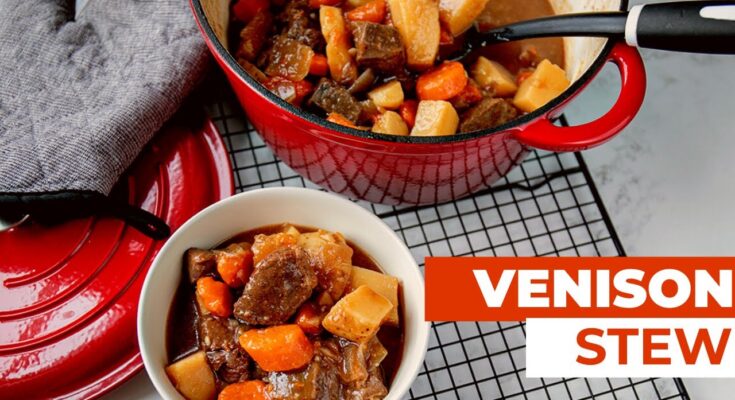Venison Stew Recipe: Venison stew isn’t your average meat dish—it’s a hearty, soul-warming meal that’s steeped in tradition, especially among hunters and those who appreciate wild game. What makes it special? It’s not just the taste, which is rich and slightly gamey, but the sense of accomplishment and connection to nature that comes with preparing it. Whether you’ve hunted the deer yourself or sourced it locally, there’s something deeply satisfying about transforming venison into a tender, flavorful stew.
Unlike beef or chicken, venison brings a unique depth of flavor that feels rustic yet refined. It stands up beautifully to robust herbs and earthy vegetables like carrots, potatoes, and parsnips. If you’re after a dinner that feels like a warm hug on a cold day, this is it.
Plus, venison is leaner than most meats, which makes this stew hearty but not heavy. It’s perfect for long autumn or winter nights, when you’re craving something nourishing but don’t want to feel sluggish afterward. It’s more than just a meal—it’s a cozy, comforting experience.
Health Benefits of Venison
Beyond its flavor, venison is a nutritional powerhouse. It’s lower in fat and cholesterol than traditional red meats like beef, yet it’s packed with protein. That means you’re getting a filling, muscle-building punch without the heaviness. For those watching their waistlines or managing heart health, it’s a smart substitute.
What’s more, venison is rich in iron, zinc, and B-vitamins—all essential nutrients that support energy levels, immune function, and red blood cell production. Since venison comes from wild deer, it’s often free from antibiotics and hormones found in commercially raised meats. It’s the kind of clean, natural eating that fits well with paleo, keto, and whole-food diets.
And let’s not forget sustainability. Wild game like deer have a lower carbon footprint compared to factory-farmed meats. If you’re conscious of your environmental impact, venison is a great choice. So, when you prepare a stew with this meat, you’re doing your body—and the planet—a favor.
Ingredients You’ll Need
Essential Ingredients for Flavorful Stew
When it comes to cooking a great venison stew, your ingredients will set the tone. You don’t need anything fancy—just good, fresh produce and a few pantry staples. Here’s what you’ll definitely need:
- Venison chunks (2-3 lbs): Cut into 1-2 inch pieces. Look for well-trimmed meat to avoid too much sinew or fat.
- Carrots (3-4): Peeled and cut into thick slices.
- Potatoes (3 large): Russet or Yukon Gold, chopped into cubes.
- Onions (2): Diced for sweetness and depth.
- Garlic (4-5 cloves): Minced for that punch of flavor.
- Celery (2 stalks): Chopped for a classic stew base.
- Tomato paste (2 tbsp): Adds umami and richness.
- Beef or venison broth (4 cups): The liquid gold that ties everything together.
- Red wine (1 cup, optional): Deepens the flavor, especially with gamier cuts.
- Bay leaves (2): Essential for that slow-cooked aroma.
- Fresh thyme and rosemary: These herbs love wild game.
- Salt and pepper: Season generously throughout the cooking process.
- Olive oil or butter: For sautéing.
Stick with these core ingredients and you’re guaranteed a stew that’s rich, hearty, and bursting with flavor.
Optional Add-Ins for Extra Richness
If you’re feeling adventurous or want to elevate your stew even more, consider these delicious add-ins:
- Parsnips or turnips: Add an earthy twist.
- Mushrooms (cremini or wild): Deepen the umami profile.
- Worcestershire sauce (1 tbsp): A secret weapon for complexity.
- Dark chocolate (1 small square): Trust me—it mellows out the gaminess and adds richness.
- Pearl onions: A gourmet touch that looks stunning on the plate.
- Smoked paprika or cayenne: For a bit of warmth and kick.
These additions are totally optional, but they give you room to customize your stew to suit your taste. Want it richer? Add more butter and wine. Want a smoky note? Toss in some smoked paprika or even a bit of bacon.
Tools and Equipment
Kitchen Tools That Make Prep Easier
The right tools don’t just make the process smoother—they can seriously elevate the final result. Here’s what you’ll want to have on hand:
- Dutch oven or heavy-bottomed pot: This is your best friend for slow cooking. It holds heat beautifully and ensures even cooking.
- Sharp chef’s knife: Cutting venison cleanly requires a good blade.
- Cutting board: Preferably one you use for raw meats.
- Wooden spoon or spatula: For stirring without scratching.
- Measuring cups and spoons: For accurate seasoning and liquid ratios.
- Tongs: Perfect for searing the meat.
- Ladle: Makes serving the stew a breeze.
If you have a slow cooker or Instant Pot, those work great too—just adjust the cooking times accordingly. But for traditional flavor and texture, nothing beats the stovetop method in a good old-fashioned Dutch oven.
Preparing the Venison
Cleaning and Cutting the Meat
Before you even think about turning on the stove, it’s crucial to prep the venison properly. Wild game meat often has sinew, silver skin, or connective tissue that needs trimming. Leaving this on can make the stew chewy or gamey—not what we want.
Start by rinsing the venison under cold water and patting it dry with paper towels. Place it on a clean cutting board and use a sharp knife to trim off any sinew or silver skin. Then, cut the meat into even chunks—about 1 to 1.5 inches is ideal. Uniform pieces ensure even cooking and tenderness.
Once cut, season generously with salt and pepper. You can stop here, or you can go one step further: toss the meat in a bit of flour. Why? Because flouring the meat helps create a delicious crust when seared and also thickens the stew later. Just be sure to shake off the excess flour before adding to your hot pot.
Marinating Tips for Tenderness and Flavor
Some folks swear by marinating venison, especially if the meat is from an older animal or has a strong gamey flavor. A good marinade can tenderize the meat and infuse it with deeper flavor.
Here’s a simple marinade you can use:
- 1 cup red wine or apple cider vinegar
- 2 tablespoons olive oil
- 2 cloves garlic, crushed
- 1 teaspoon thyme
- 1 teaspoon black pepper
Marinate in the fridge for 4–8 hours. Drain and pat the meat dry before cooking. This step is optional but recommended if you want an ultra-flavorful, tender result. If you skip the marinade, no worries—you’ll still get a delicious stew. But if you’ve got the time, go for it. It makes a noticeable difference.
Step-by-Step Cooking Instructions
Step 1 – Searing the Venison
Searing your venison is where the magic begins. This step develops deep, caramelized flavor that’s crucial to any good stew. You’re not just browning meat—you’re building a foundation.
Heat a couple of tablespoons of olive oil or butter in your Dutch oven over medium-high heat. Once it’s shimmering (but not smoking), add the venison chunks in batches. Don’t overcrowd the pan! If you dump all the meat in at once, it will steam instead of sear—and you’ll lose out on all that lovely flavor.
Let the meat brown on all sides. Don’t rush it. Each side should get a rich, brown crust. This is where you’re layering in flavor that will carry through the entire dish. Remove the seared meat and set it aside on a plate. You’ll notice brown bits (fond) at the bottom of the pot—don’t clean those up. That’s liquid gold for flavor.
Step 2 – Sautéing the Aromatics
With the venison set aside, it’s time to get your aromatics going. Reduce the heat slightly and add a bit more oil if needed. Toss in your chopped onions, celery, and garlic. Cook these down until the onions turn translucent and everything smells amazing—this usually takes about 5–7 minutes.
This step softens the veggies and releases their natural sugars, adding depth and sweetness to the stew. Be sure to scrape up the browned bits from the bottom of the pot as you stir. That’s where a lot of the seared flavor hides, and it’s what gives your stew that “slow-cooked for hours” richness.
At this stage, add your tomato paste. Stir it in and let it cook for a minute or two—it should darken slightly. This helps mellow out the acidity and deepens the stew’s flavor. Don’t skip this little trick!
Step 3 – Simmering for Richness
Time to bring everything together. Add your venison back into the pot, then pour in the broth and wine (if using). Toss in your bay leaves, fresh thyme, and rosemary. Stir everything gently, making sure the meat is well-distributed and submerged in the liquid.
Bring the stew to a light boil, then immediately reduce the heat to low and cover the pot. Let it simmer for at least 1.5 to 2 hours. This low-and-slow method is the secret to making the venison melt-in-your-mouth tender.
As it simmers, the flavors will meld beautifully. You’ll start to notice the broth thickening slightly and taking on a rich, dark hue. Check occasionally to stir and ensure nothing’s sticking to the bottom. Add a bit more broth or water if it gets too thick.
About 45 minutes before the end of cooking, add in your potatoes and carrots. They’ll soak up the savory juices and soften perfectly without turning mushy.
Step 4 – Final Touches and Thickening
After your stew has simmered to tender perfection, it’s time to finish it off. First, taste and adjust the seasoning. You might want to add more salt, pepper, or a splash of Worcestershire sauce for depth.
To thicken the stew even more, make a quick slurry: mix 1 tablespoon of flour or cornstarch with 2 tablespoons of water. Stir it into the stew and let it simmer uncovered for another 10–15 minutes. The sauce will tighten up to a rich, velvety consistency.
Remove the bay leaves and herb stems. Give the stew a final stir and admire how everything’s come together—the tender meat, the soft vegetables, and that glossy, flavorful gravy. You’re almost ready to eat!
Serving Suggestions
Best Sides to Pair With Venison Stew
A great stew deserves an equally great side dish. You want something that complements the rich flavors without overpowering them. Here are a few go-to options:
- Crusty bread or dinner rolls: Ideal for soaking up every last bit of gravy.
- Mashed potatoes: Serve the stew over a bed of buttery mashed potatoes for ultimate comfort food vibes.
- Buttered noodles or rice: A lighter alternative that lets the stew shine.
- Polenta: Creamy, cheesy polenta adds a touch of luxury to the meal.
For something green on the side, consider steamed green beans, sautéed kale, or a crisp salad with a light vinaigrette. The freshness balances the richness of the stew beautifully.
Feeling festive? Pair the dish with a glass of red wine—something bold like Cabernet Sauvignon or Syrah works well. Or go for a hearty ale if you prefer beer.
Garnishing Tips for Presentation
You’ve put love and effort into this dish—now make it look as good as it tastes. A few garnishing tricks can elevate your stew from rustic to restaurant-worthy:
- Chopped fresh parsley or thyme: Adds color and a touch of brightness.
- Drizzle of olive oil or truffle oil: A gourmet finish.
- Cracked black pepper or smoked salt: A sprinkle right before serving adds flavor and crunch.
- Grated hard cheese (like Parmesan or aged Gouda): Just a touch adds a savory note.
Presentation may not change the flavor, but it sure enhances the experience. Even a humble stew feels fancy with a little flair.
Storing and Reheating Leftovers
Proper Storage Techniques
Got leftovers? Lucky you—venison stew only gets better the next day. The flavors deepen, the meat becomes even more tender, and the sauce thickens up beautifully. But you’ve got to store it right to keep it fresh and safe.
Let the stew cool completely before storing. Don’t rush this step—putting hot food in the fridge can create condensation, which affects both flavor and texture. Once it’s cool, transfer the stew into an airtight container. If you’ve made a big batch, divide it into smaller containers for quicker cooling and easy reheating.
Refrigerated venison stew will stay fresh for 3 to 4 days. For longer storage, pop it in the freezer—it’ll last up to 3 months. Just be sure to leave a little room at the top of your container, as the stew will expand as it freezes.
Label your containers with the date so you’ll know exactly how long it’s been sitting. Trust me, future you will thank you for the reminder.
Best Reheating Methods
When you’re ready to enjoy those leftovers, reheating is a breeze. You’ve got a few options depending on how much time you have.
- Stovetop (Best for Flavor and Texture): Pour the stew into a pot and heat over medium-low. Stir occasionally to prevent sticking, and add a splash of water or broth if it seems too thick. This method brings back all those slow-cooked flavors perfectly.
- Microwave (Quick and Convenient): Scoop a portion into a microwave-safe bowl, cover loosely, and heat in 60-90 second intervals, stirring in between. Be careful not to overheat—it can dry out the meat.
- Oven (For Large Batches): Preheat your oven to 325°F (163°C), place the stew in a covered oven-safe dish, and heat for 20-30 minutes. This works well if you’re serving it to guests and want to keep it hot and bubbly.
Avoid reheating more than once, as this can compromise the texture of the meat and the overall flavor of the stew. Instead, just reheat what you’ll eat, and keep the rest chilled.
Common Mistakes to Avoid
How to Keep Venison from Getting Tough
One of the biggest challenges when cooking venison? Avoiding that tough, chewy texture. Venison is a lean meat, so it’s more sensitive to overcooking than fatty cuts like beef. But don’t worry—we’ve got some solid tricks to keep your meat fork-tender.
- Don’t skip the sear: Browning the meat before simmering locks in moisture and starts flavor development early.
- Low and slow wins the race: Venison needs gentle, prolonged heat to break down its fibers. A fast boil will only make it rubbery.
- Cut against the grain: When chopping your meat, slice across the muscle fibers, not with them. This makes a big difference in tenderness.
- Use enough liquid: A dry pot equals dry meat. Make sure there’s always enough broth or sauce to cover the meat as it simmers.
Following these steps will result in a stew that’s rich, tender, and full of character—no tough bites allowed.
Balancing Flavors Without Overpowering the Meat
Venison has a distinct flavor. It’s earthy, slightly gamey, and more complex than your average supermarket steak. But that doesn’t mean you should drown it in spices or sauces. The key to a great stew is balance.
Here’s how to do it right:
- Don’t go heavy on salt early: Let the stew simmer before doing your final seasoning. This prevents over-salting and helps flavors develop naturally.
- Avoid overpowering herbs or spices: Strong spices like cumin or curry can clash with venison’s flavor. Stick with classics like thyme, rosemary, bay leaf, and garlic.
- Use acid wisely: A splash of red wine or a squeeze of lemon at the end can brighten the dish, but don’t go overboard.
- Layer your flavors: Build slowly—from searing the meat to sautéing the vegetables, to adding herbs and broth. Every step adds a layer of flavor that makes the final dish sing.
It’s all about enhancing the natural flavor of venison, not masking it. With a light touch and a little patience, you’ll create a dish that’s both rustic and refined.
FAQs about Venison Stew Recipe
Q1: Can I make venison stew in a slow cooker?
Yes! Just sear the meat first, then transfer everything to a slow cooker. Cook on low for 7–8 hours or on high for 4–5 hours.
Q2: What can I substitute for red wine in the recipe?
You can use beef broth with a splash of balsamic vinegar or red grape juice. The goal is to add depth and a touch of acidity.
Q3: Is venison stew gamey in taste?
It can be, depending on the age of the deer and how it was processed. Marinating helps mellow out any strong flavors.
Q4: Can I freeze venison stew?
Absolutely. Store in airtight containers and freeze for up to 3 months. Thaw overnight in the fridge before reheating.
Q5: What’s the best cut of venison for stew?
Shoulder or leg cuts are perfect. They’re tougher but full of flavor, and they become tender with slow cooking.
Conclusion
Venison stew is more than just a meal—it’s a celebration of comfort, tradition, and bold flavor. Whether you’re a seasoned hunter or a first-timer curious about wild game, this recipe gives you a fail-proof path to a rich, hearty, and deeply satisfying dish. With each tender bite, you taste not just the ingredients, but the care, time, and love poured into every step.
From prepping and marinating the meat to building layers of flavor through careful cooking, this dish rewards your effort tenfold. Serve it up with a warm side, garnish it to impress, and enjoy it solo or with friends and family. One thing’s for sure: once you’ve had a good venison stew, it’ll earn a permanent place in your recipe rotation.



